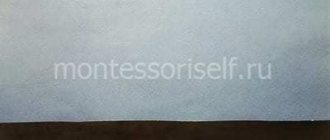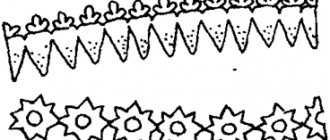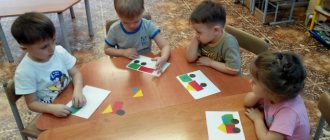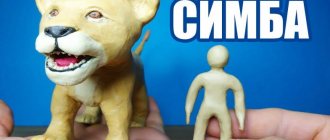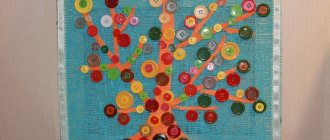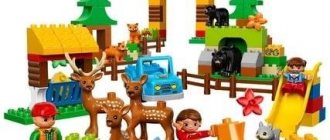<…1. Introductory part. Organizational moment (2 min.). Children enter the hall. Greet guests. Teacher: - Guys, do you like to travel? (children's answers) - What can you go on a journey with? (children's answers) - Is it possible to walk? (children's answers) - I suggest you go to a magical, fairy-tale clearing... - Oh, guys, look: someone's footprints? Whose tracks do you think these are? Let's see where they take us? Children follow in the footsteps of the teacher. The children go into the hall, there they find a felt boot lying in a “snowdrift”. Teacher: - Here is our magical clearing. Oh, guys, look what it is here in the snowdrift? (children's answers) - Which of you guys have felt boots? Maybe some of you have lost it? (children's answers) - Then let's leave it here, suddenly the one who lost it will return (children's answers).
- Main part.
Listening to K.I. Chukovsky’s poem “The Miracle Tree” (5–7 min.). - Guys, I already told you that a fairy tale awaits you here. So, this good fairy tale is the poem “The Miracle of a Tree,” and it was written by Korney Ivanovich Chukovsky (portrait of K. I. Chukovsky, slide 1). – Now, guys, sit down more comfortably, now we will listen to this poem performed by the author himself, Korney Ivanovich Chukovsky. Children sit on chairs and listen. (Slide 2, 3) - Guys, why was the tree in the fairy tale that we listened to called wonderful, a miracle - a tree? (slide 4) (children's answers) - Guys, you know that shoes are seasonal. Tell me, what is the name of the shoes we wear in the summer? (in one word) In autumn? In winter? (children's answers) - Guys, guess the riddle? Not shoes, not boots, But feet wear them too, We run in them in winter, In the morning - to kindergarten, in the afternoon - home! Children: Valenki (slide 5). Teacher: - Guys, Dasha knows a poem about felt boots, and now she’ll tell us about it. The child recites a poem. Teacher: - Guys, what do you know about felt boots? (children's answers) - Do you know how felt boots are made? Do you want me to tell you? (Children's answers) Show a presentation about felt boots, their properties, stages of production, decor options (3 min.). (slide 6) Valenki is a simple Russian word. From time immemorial they have been an integral part of Russian costume, Russian winter. The felt boots are rustic, but also durable, reliable, and will not let you down in difficult times! Valenki are comfortable and healing shoes. In felt boots we are not afraid of the most severe frosts. Felt boots are soft winter boots made of wool (slide 7). Felting a felt boot means rolling the wool into a certain shape - the shape of a felt boot. But felt boots are produced only in Russia, and the tradition of this craft is passed on from generation to generation. (slide Valenki are the only shoes made entirely from natural materials: wool is simply sheared from sheep and processed - felted. And felted like this: they treated the wool with boiling water, steam, smoke, knocked it into a total mass (slide 9) - felt - and rolled it - first on the table (slide 10), and then on a block of the required size... (slide 11) Felt boots of different colors were rolled from sheep's wool: black, gray and white (slide 12). (slide 13) Nowadays, very often craftsmen decorate felt boots with various appliqués, with embroidery, they paint felt boots in different colors. Look how different the felt boots are, how unusual they are... And in addition to the ordinary felt boots that you and I wear, craftsmen make decorative felt boots, souvenir ones. - Guys, let's decorate that felt boot that you and I found , I think that the owner of this felt boot will not mind. A surprise moment (3 min.). The children notice that the felt boot has disappeared, and in its place a tree has grown in a snowdrift. The teacher pulls the cape off the crown of the tree. The felt boots are hanging on it (paper templates made of multi-colored cardboard). Teacher: - Guys, our clearing really turned out to be magical! In the place where the felt boot lay, a tree grew! Look, the felt boots are ripe on our tree! What a tree, a wonderful tree!!! – Tell me, who usually sits on tree branches instead of felt boots in winter? (children's answers) - Guys, do you want to decorate our felt boots with bright appliqués? (children's answers) -Let's decorate the felt boots with applications - birds: bullfinches and titmice. Teacher: - Russians love to wear felt boots in the winter. In the cold, we can create a miracle out of felt boots - a fairy tale. And for this we need to go to the workshop. Will you help me? Choose one felt boot for yourself and take it with you. Children choose a template to work with. Performing the application (15 min). Children go to their work places and sit down. Educator: -Before we get to work, let's remember what felt boots are made of? (Children's answers). – Yes, that’s right, to make felt boots you need sheep’s wool. I have regular wool, and I have dyed wool. Look, touch, what is she like? – I made these little souvenir felt boots from this wool. (The teacher shows small felt boots, felted with his own hands). (Children's answers). – What else do you think wool is used for? (children's answers) - Yes, in addition to felt boots, yarn and threads are made from wool (children's answers). – So for our applique we will need pompoms made of wool yarn. Choose any pompom you like. Take it in your hands, touch it. Do you feel warm? (children's answers) - Tell me, what do these fluffy balls look like? Do they look like birds? - This is the kind of felt boot you should get. (Showing a finished sample for making an application). You have everything you need for work on your tables. (Let's think about how we can make a bird out of these parts?) Now I will show you the sequence of work. To begin with, let’s draw (with a felt-tip pen) a twig on our felt boots on which the bird will sit. Will those with a yellow pompom do it? (titmouse), and those with red ones? (bullfinch). To make the base of our bird, we need a black rectangle, we must turn it into an oval, cutting off and rounding all the corners (the teacher shows the process of rounding the corners, reminds us that the scissors must be held correctly). Then we coat the resulting oval (base) with glue and glue it onto the felt boot template. From a small rectangle, cutting it diagonally, we get a tail and a wing. At the triangle-wing, we round off two corners to form a droplet. Glue all the missing parts (tail, wing, beak and eye). We glue the finished white piece of a smaller size onto the wing. To apply glue to parts, we use oilcloths and a napkin to remove excess glue. Apply glue to the belly of the resulting bird and attach a pompom. (You can use cotton wool to stick a snowball on the branches.) Children do the work. The teacher gives advice, approaches those who have difficulty doing the work, and helps. - And now, in order for our birds to straighten their feathers, we need to warm them up with our warmth, let’s breathe on them like this, stroke them with our palms. - And before we hang them back on the tree, you and I need to find a pair for our felt boots. The children get up and find a couple. Teacher: - Now let’s hang each pair of felt boots on its own branch. Children approach the tree and hang their felt boots on the tree.
- Guys, I already told you that a fairy tale awaits you here. So, this good fairy tale is the poem “The Miracle of a Tree,” and it was written by Korney Ivanovich Chukovsky (portrait of K. I. Chukovsky, slide 1). – Now, guys, sit down more comfortably, now we will listen to this poem performed by the author himself, Korney Ivanovich Chukovsky. Children sit on chairs and listen. (Slide 2, 3) - Guys, why was the tree in the fairy tale that we listened to called wonderful, a miracle - a tree? (slide 4) (children's answers) - Guys, you know that shoes are seasonal. Tell me, what is the name of the shoes we wear in the summer? (in one word) In autumn? In winter? (children's answers) - Guys, guess the riddle? Not shoes, not boots, But feet wear them too, We run in them in winter, In the morning - to kindergarten, in the afternoon - home! Children: Valenki (slide 5). Teacher: - Guys, Dasha knows a poem about felt boots, and now she’ll tell us about it. The child recites a poem. Teacher: - Guys, what do you know about felt boots? (children's answers) - Do you know how felt boots are made? Do you want me to tell you? (Children's answers) Show a presentation about felt boots, their properties, stages of production, decor options (3 min.). (slide 6) Valenki is a simple Russian word. From time immemorial they have been an integral part of Russian costume, Russian winter. The felt boots are rustic, but also durable, reliable, and will not let you down in difficult times! Valenki are comfortable and healing shoes. In felt boots we are not afraid of the most severe frosts. Felt boots are soft winter boots made of wool (slide 7). Felting a felt boot means rolling the wool into a certain shape - the shape of a felt boot. But felt boots are produced only in Russia, and the tradition of this craft is passed on from generation to generation. (slide Valenki are the only shoes made entirely from natural materials: wool is simply sheared from sheep and processed - felted. And felted like this: they treated the wool with boiling water, steam, smoke, knocked it into a total mass (slide 9) - felt - and rolled it - first on the table (slide 10), and then on a block of the required size... (slide 11) Felt boots of different colors were rolled from sheep's wool: black, gray and white (slide 12). (slide 13) Nowadays, very often craftsmen decorate felt boots with various appliqués, with embroidery, they paint felt boots in different colors. Look how different the felt boots are, how unusual they are... And in addition to the ordinary felt boots that you and I wear, craftsmen make decorative felt boots, souvenir ones. - Guys, let's decorate that felt boot that you and I found , I think that the owner of this felt boot will not mind. A surprise moment (3 min.). The children notice that the felt boot has disappeared, and in its place a tree has grown in a snowdrift. The teacher pulls the cape off the crown of the tree. The felt boots are hanging on it (paper templates made of multi-colored cardboard). Teacher: - Guys, our clearing really turned out to be magical! In the place where the felt boot lay, a tree grew! Look, the felt boots are ripe on our tree! What a tree, a wonderful tree!!! – Tell me, who usually sits on tree branches instead of felt boots in winter? (children's answers) - Guys, do you want to decorate our felt boots with bright appliqués? (children's answers) -Let's decorate the felt boots with applications - birds: bullfinches and titmice. Teacher: - Russians love to wear felt boots in the winter. In the cold, we can create a miracle out of felt boots - a fairy tale. And for this we need to go to the workshop. Will you help me? Choose one felt boot for yourself and take it with you. Children choose a template to work with. Performing the application (15 min). Children go to their work places and sit down. Educator: -Before we get to work, let's remember what felt boots are made of? (Children's answers). – Yes, that’s right, to make felt boots you need sheep’s wool. I have regular wool, and I have dyed wool. Look, touch, what is she like? – I made these little souvenir felt boots from this wool. (The teacher shows small felt boots, felted with his own hands). (Children's answers). – What else do you think wool is used for? (children's answers) - Yes, in addition to felt boots, yarn and threads are made from wool (children's answers). – So for our applique we will need pompoms made of wool yarn. Choose any pompom you like. Take it in your hands, touch it. Do you feel warm? (children's answers) - Tell me, what do these fluffy balls look like? Do they look like birds? - This is the kind of felt boot you should get. (Showing a finished sample for making an application). You have everything you need for work on your tables. (Let's think about how we can make a bird out of these parts?) Now I will show you the sequence of work. To begin with, let’s draw (with a felt-tip pen) a twig on our felt boots on which the bird will sit. Will those with a yellow pompom do it? (titmouse), and those with red ones? (bullfinch). To make the base of our bird, we need a black rectangle, we must turn it into an oval, cutting off and rounding all the corners (the teacher shows the process of rounding the corners, reminds us that the scissors must be held correctly). Then we coat the resulting oval (base) with glue and glue it onto the felt boot template. From a small rectangle, cutting it diagonally, we get a tail and a wing. At the triangle-wing, we round off two corners to form a droplet. Glue all the missing parts (tail, wing, beak and eye). We glue the finished white piece of a smaller size onto the wing. To apply glue to parts, we use oilcloths and a napkin to remove excess glue. Apply glue to the belly of the resulting bird and attach a pompom. (You can use cotton wool to stick a snowball on the branches.) Children do the work. The teacher gives advice, approaches those who have difficulty doing the work, and helps. - And now, in order for our birds to straighten their feathers, we need to warm them up with our warmth, let’s breathe on them like this, stroke them with our palms. - And before we hang them back on the tree, you and I need to find a pair for our felt boots. The children get up and find a couple. Teacher: - Now let’s hang each pair of felt boots on its own branch. Children approach the tree and hang their felt boots on the tree.
- Final part (5 min.)
The teacher offers to relax after work. - Guys, we have worked hard, it’s time to rest. Let's get into a round dance. The Russian folk song “Like thin ice” sounds for you. A round dance is performed: “Like on thin ice.” During the round dance, Vanyushka (a student from the preparatory group) appears on a horse and wearing only felt boots, falls, and is lifted up by two girls. Teacher: -Oh, Vanyusha, aren’t you hurt? Vanyusha: No! I fell for fun, I wanted to make you laugh a little! - Guys, have you seen my felt boots here, have I lost it? (children's answers) Teacher: -Guys, tell Ivanushka what happened to his felt boots? (Children's answers) - In our magical clearing, instead of your felt boots, a miracle tree grew, as in the fairy tale of Korney Ivanovich Chukovsky, and on it the felt boots ripened. Look how our guys decorated them. - Guys, let's give Vanya a pair of new felt boots? (children's answers) - Choose, Ivanushka, which ones you liked! Vanya chooses felt boots and thanks the guys. Vanya: - Oh, thanks, guys, you helped out! And I have gifts for you (takes out sweet cockerels on sticks from a bag and distributes them to the children). When I was galloping towards you, I saw another miracle tree on the way, would you like to see it? Then everything is behind me!..>
Summary of GCD for appliqué in the preparatory group “Ball Gown for Cinderella”
Summary of GCD for appliqué in the preparatory group “Ball Gown for Cinderella”
Educational objectives:
—
introduces the profession of a fashion designer, inventing and creating unusual dresses from paper using the applique technique
- use materials of different textures to create an expressive image;
Developmental tasks:
— develop creative abilities, the ability to think outside the box, do work carefully, and finish what you start.
Educational tasks:
— cultivate accuracy in working with paper and glue, independence
Preliminary work:
looking at illustrations in children's books, watching the cartoon “Cinderella” by C. Perrault. Photo exhibition of festive children's clothing, a doll with a set of outfits.
Material, tools, equipment:
album sheet, glue, brushes, scissors, stencil pattern for a dress made of colored cardboard, white lace napkins, details and decoration elements for the dress, napkins for hands, oilcloth for tables, pictures of ballroom and elegant dresses, picture of a fashion designer
PROGRESS
IN.:
— Guys, do you remember the fairy tale about Cinderella? What dress did Cinderella wear to work? Can she go to the ball in it? Why? Who helped Cinderella find a beautiful outfit? Did she have a choice in choosing an outfit?
IN.:
— Where do you choose your outfits? What should poor Cinderella do? So we helped her solve the task of the evil stepmother, but how can we help her here?
IN.:
— Look at the clothing exhibition. What is she like? (Dressy.) How is it different from everyday clothes? (fabric, color, decoration.) What is this dress decorated with? (Bows, lace.) Is it comfortable to work in such a dress? Clean the floor? (No, it’s long, white lace, satin bows.) Where can you go in such outfits? (For a matinee in kindergarten, at the theater, for a birthday, at a museum.)
IN.:
— Guys, do you know who sews clothes? Before the tailor sews an outfit, an artist will design and draw it. Such artists are called “fashion designers”, “designers”. They come up with new styles of clothes, making them comfortable and elegant. The profession of a fashion designer requires imagination, invention, and a developed sense of beauty. And in order for the tailor to sew the dress correctly, the fashion designer makes a sample and a pattern.
IN.:
— Tell me, what parts does the dress consist of? What elements are on the top of the dress?
IN.:
— Various lines, straight, curved, rounded, can make a dress unusual. They can be in the form of stitching, piping, ruffles, sequins, various draperies, tucks, folds, lines can divide the shape of the dress and hide all the imperfections of the figure.
IN.:
— Guys, would you like to become fashion designers for a while and make a dress for Cinderella?
IN.:
-I invite you to the workshop. What can you and I make a dress from in our workshop? We have multi-colored stencils - patterns. Choose which one you like and take your seats.
IN.:
- Using this pattern, with the help of a lace napkin and details for decorations, you need to make an elegant dress. What tools might you need? (scissors, brush, glue, hand wipes)
IN.:
— Guys, do you remember how to handle scissors and glue (children tell the rules for handling scissors and glue)
IN.:
— We have a step-by-step work plan in our workshop. Tell us what you see in the diagram and where we should start working.
Children tell the stages of work
1. Take a white lace napkin and fold it in half.
2. Unfold it and cut it into two parts with scissors along the fold line.
3. Fold one half of the napkin in half again.
4. Unfold the napkin and fold the right and left sides towards the fold line.
IN.:
- What figure did we get? (triangle). Bend the upper corner of the triangle a little, what have we got? What does it look like?
IN.:
- Now glue the resulting skirt to the dress pattern.
IN.:
- Now let’s do a little warm-up.
Physical exercise: “Dressy shoes”
Dressy shoes, (right foot forward, on the toe)
Dress shoes, (left foot forward, on the toe)
Varnish, with a strap, (right foot forward, on the heel)
And a sole with a heel. (left foot forward, on the heel)
Masha's shoes are just right for going out dancing. (hands on the belt, “dancing”)
IN.:
- Well, shall we continue working? The dress turns out beautiful, but is there something missing? That’s right, it’s not very elegant, so I suggest adding some jewelry. Before you lies the details of decorations for the dress, choose the ones you like and decorate the dresses with them.
Children decorate their dresses and paste them onto a scrapbook sheet.
IN.: -
Oh guys, what beautiful dresses we made, and now let's place our dresses on display, like in a store window, so that Cinderella can choose a dress for the next ball.
IN.:-
I think that Cinderella will be very pleased with your work, but what do you think about your work? Which dress turned out better and neater? What is it decorated with? Which dress would you choose for the ball? What dress would you wear to the theater?
IN.:
— If we glue all your works together, like pages in a book, then we will get the fashion magazine “Dress for the Ball”
